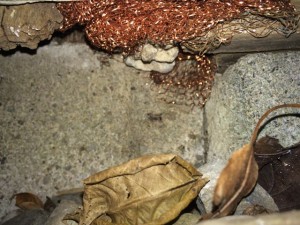So you’re thinking of a trip south, camper or boat in tow, or maybe a little winter getaway to your cabin in the North Country. For “no surprises” trip prep, take advantage of every spell of mild weather to make sure you’ve
- kept rodents from settling into cozy quarters (or disinvite those that have)
- removed those enticing extras that make critters do their best to bust through your defenses
Here’s the IPM approach. Put on your overalls, grab a flashlight, and crawl under

your camper or into the crawl space under your cabin — or climb up a ladder to take a closer look at your eaves and loose siding as well as cable entry points. Plug every likely entry point and with something like copper stuff-it — a fine wire mesh that helps keep critters out — or by caulking those places where propane pipes, internet cables, or phone or electric lines come in.
Be careful. If need be, hire an electrician. Even turning off the breaker box doesn’t mean dangerously high voltage won’t zap you.
This can be tricky work, because rodents can squeeze through what look like impossibly small spaces. Sometimes they’ll pull out your wire mesh, but caulk worked into the mesh — or a spray foam that expands into it — will help keep the mesh in place. So look again. And know that foam alone won’t do the trick — even if the can says it deters mice, chipmunks, and the like.
Besides critter-deterrent foam, here’s what else won’t provide long-term control: ultrasonic devices and boom boxes blasting rap music (yes, it’s been tried!). Sure, you might get short-term control — but critters acclimate to predictable or constant sounds. And forget that persistent rumor that mothballs (or dryer sheets) will deter them. For one, it’s illegal to use mothballs this way. And any seeming deterrence is probably illusory.
If rodents haven’t made your camper or cabin home yet — if you don’t see mouse poop, for instance — count your blessings and roll up your shirtsleeves. Besides the obvious (boxes of crackers, say, or plastic jars of peanut butter), remember that crumbs beneath the couch cushions or inside drawers and hard-to-reach corners attract critters with sensitive noses.
Because rodents appreciate a cozy place to curl up as much as you do (and because prevention is key to good IPM), stash everything from paper napkins to blankets and pillows in tightly sealed containers. If you can, empty the drawers; leaving them open makes the space less of a hidey-hole — and less appealing.
Occasionally you might do such a good job on the outside, you actually trap a critter that was already inside your walls when you began. Though it seems harsh, the best thing is to place snap-traps at those key exit points you discovered during your inspection — and check them as often as you can. (Animals caught in live traps and released elsewhere often end up in some other critter’s territory, and the consequences aren’t all that pretty.)
Traps come in two sizes: mouse and rat; rat traps work also for squirrels and chipmunks. What size to put out? If you hear noise at night it’s probably a mouse or rat. If during the day, it’s probably a chipmunk or squirrel.